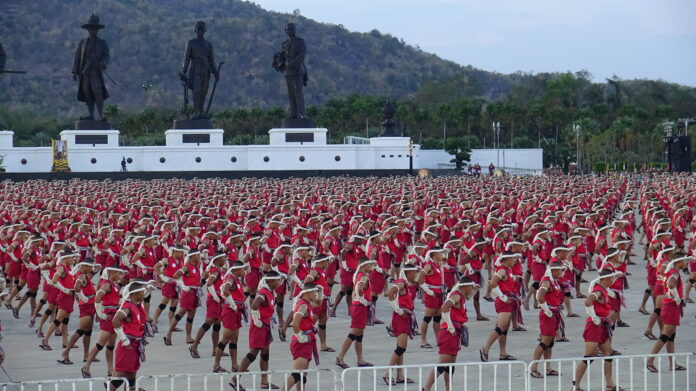
As I type these words, some Thai and Cambodian trolls are doing their mighty best to undermine the future cultural relations between the two countries. The rocky cultural relations between the two neighbors with so much cultural commonality is now more of hate than love relations.
The claim that Thai boxing or Muay Thai (มวยไทย) was originally an adaptation from Cambodian kickboxing or Kun Khmer and the introduction of Kun Khmer to the 32nd Southeast Asian (SEA) Games have set off a frenzy of cultural chauvinistic battles on both sides of the border, particularly after Thailand has refused to participate in Kun Khmer competition during the SEA Games this May.
The Thai Army returned fire by enlisting 3,650 Thai soldiers and cadres to perform a pre-bout reverential dance earlier this week and have the Guinness Book of World’s Records to be a witness with PM Gen. Prayut Chan-o-cha on site. The performance was led by no less than Muay Thai boxing legend Buakaw Banchamek. It was a symbolic message sent to Cambodia as much as a (tax-wasting) attempt to assure locals of the uniqueness of Thai boxing.
In Cambodia, the Khmer Times reported on Feb. 3 that the honorary chairman of Khmer Boxing Federation Oknha Srey Chanthorn has announced on social media that he will award his villa valued at 270,000 U.S. dollars to any Cambodian boxer who can defeat Buakaw. If a villa is not enough of an incentive, a beautiful Cambodia net idol, Yada Yada, also made a similar pledge with the ultimate prize being the Cambodian boxer who could beat Buakaw can marry her.
It is on social media where the real battles are being fought, however. On the Thai side, Facebook groups such as “Claimbodia” (yes, this is not a typo), with 3,700 members, has been doing its best to look down, degrade, and poke fun of Cambodian culture, as well as its ancient heritage and history. There are equivalents on the other side of the border accusing Thailand of basically being a Copyland. One can spend hours daily reading these degrading comments by trolls from both sides but the real casualty of such war is the future of Thai-Cambodia relations.
Some say this is an attempt by the powers in Phnom Penh to unite Cambodians against a common (perceived) enemy – the larger neighbor Thailand – while distracting its people from domestic problems and politics. Others say Cambodia feels threatened by the growing soft power of Thailand, thus the reactions. Whether that is truly the case or not, Thais should calm down and consider the future peaceful coexistence between the two nations. Neither Thailand nor Cambodia can relocate its country or deny the shared border, history, and cultures that we have (and should enjoy).
Once upon a long time ago, or between the 9th to 15th century to be more precise, much of the central Thai plains and the northeast was under the influence (or even a part) of the great Angkorian Empire. (Thus as a Thai, I see myself as having an Angkorian cultural heritage in me as well, partially an heir if you will). This means we, as central Thais, inherit aspects of the Angkorian (or ancient Khmer) culture.
Things get complicated with the subsequent rise of the Ayutthaya Kingdom, in what is today Thailand, which in turn, influenced its neighbor to the east. This cultural fusion and transfer went on until the early Bangkok period when France colonized Cambodia and integrated it as part of French Indochina in 1887. The cultural interactions between the two nations cannot be easily (if ever) be disentangled through nationalistic lens due to its complexity and fluidity of the shared heritage and cultures.
Thais should be happy that something almost identical to Thai boxing is being spread by Cambodians, while Cambodians should also be delighted that Thai boxing is very similar to Kun Khmer as both nations will (hopefully together) promote Thai-Khmer or Khmer-Thai kickboxing to the world and make it even more popular. Think of sepak trakaw, or kick volleyball, popular among Thais and Malaysians. The word “sepak” is Malay for kick while “takraw” is Thai and means woven rattan ball. It was a successful compromise between Thailand and Malaysia struck in Kuala Lumpur back in 1960. We need not go to war for an exclusively nationalistic name.
The sport belongs to both Thailand and Malaysia (as well as Indonesia and Singapore) and perhaps even a few more neighboring countries. It did not have to be exclusively Thai or Malay for that matter because many cultural heritage knows no rigid national boundary as nationalism and national borders came much later.
Scholars from both nations should consider conducting a joint research on the origin of both Kun Khmer and Muay Thai that transcend the narrow nationalistic lenses and perhaps in the future, we might want to discuss the possibility of sharing a common name for Muay Thai and Kun Khmer.











































